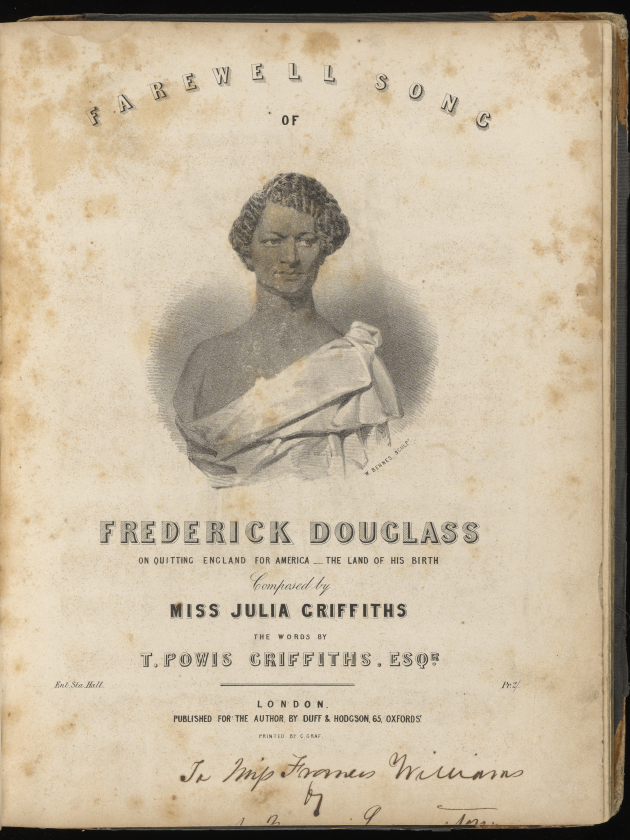BY DANIEL J. KUSHNER
At New York City’s Swann Auction Galleries last March, the University of Rochester successfully bid on a weathered but well-kept book of 17 songs. Perhaps the most intriguing piece in the bound collection of sheet music is a song inspired by abolitionist and long-time Rochesterian Frederick Douglass.
According to Autumn Haag, the university’s Special Collections Librarian and Archivist for Research & Collections, this copy of the song is the only one of its kind in the United States. Another copy resides in the British Library.
Entitled “Farewell Song of Frederick Douglass,” the song’s music — scored for voice and piano — was written by an English composer and abolitionist named Julia Griffiths. The songwriter met Douglass in England in 1847, the year the song was published, and later moved to Rochester and became the Douglass’s business manager. Incidentally, Griffiths’ sister married Douglass’s printer John Dick.
Griffiths’ brother, a lawyer named T. Powis Griffiths, penned the lyrics. Subtitled “On Quitting England for America — the Land of His Birth,” the words decry the fact that America is a country of slavery. Written from Douglass’s perspective, the prospect of dying in the fight against slavery is seriously considered, and ultimately the battle is joined.
After his first autobiography, “Narrative of the Life of Frederick Douglass,” was published, Douglass traveled to the United Kingdom. He had taken his freedom in 1838, but was still at risk of being captured by slave hunters, so he left the United States until the notoriety created by his book died down. Douglass conducted a series of lectures in the UK, and while there a group of friends raised the funds to buy his legal freedom. When he returned to the US, Douglass began publishing his vital abolitionist newspaper, The North Star, in Rochester.
In addition to capturing a pivotal moment in Douglass’s life, the document itself — functioning as a commemorative piece — is also fascinating for its depiction of Douglass on the cover page. Here he is seen as young man in his 20’s, clean-shaven and wearing a toga. The image evokes a vision for humanity steeped in idealism, while sending an inherently strong public relations message.
“We know Frederick Douglass was really aware of his self-image,” Haag says. “He was the most photographed man of the 19th century. And I just love how absolutely stylish that is. It’s very striking, it’s very dramatic. I would love to know whether he had a hand in that, whether he had a say, because it’s very dishy.”
The collection containing this distinctive image and its accompanying song was owned by a Francis Williams, whose name is inscribed on the book’s cover. Haag wanted to learn more about who this person might be, and her search yielded results that seem more than coincidental.
In the back of the book, Haag found a loose piece of sheet music that had been printed in a Cincinnati newspaper. Looking for a Miss Francis Williams in that area of Ohio, Haag found a Hamilton County record of a woman by that name who, in 1854, married Peter H. Clark, an abolitionist, teacher, politician, and editor. A year later, Douglass hired Clark to assist him in publishing his paper. Clark moved to Rochester, purportedly living with the Douglass family.
A middle-class African-American couple, Clark and Williams each came from mixed race families in Ohio. Williams attended Oberlin College, where she studied music, among other subjects. Though there is no way to make a definitive conclusion, Haag feels strongly about the book’s provenance.
“I feel like this is a lost piece of Douglass history,” Haag says. “Before this came up to auction, only one other copy in England. And it really feels like it was meant to be in Rochester. I feel pretty sure, pretty confident that this book was in Rochester, that the owner lived in Rochester, if only for a brief period of time. I feel pretty confident that that book might have even been in the Douglass home.”
Although the music was written in honor of Douglass, ultimately the composition and the book that contains it may provide a clearer snapshot of the individuals surrounding the great abolitionist than of the man himself.
“What excites me the most is that it seems like it’s fairly likely that it was an African-American woman who owned this book,” Haag says. “And when we think of the middle class in America in the 19th century, I think we often think white, and we don’t think African-American. And so, Cincinnati, other cities including Rochester — they had an African-American middle class who were literate, who were musical, who were running newspapers, editing newspapers, running for political office.”
Haag says that the intention is for the song to be played in concert in Rochester later this year. “I’m just really excited to hear it performed, she says. “That’s what I think is the next step for this piece. I don’t know — it could be 150 years since it’s been performed.”

